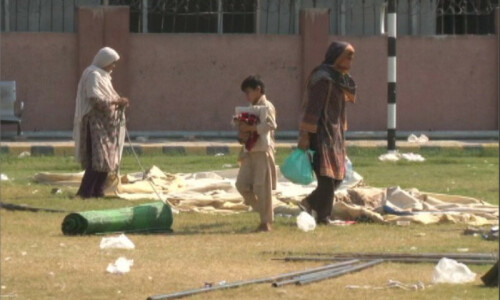September 2, 2022
ISLAMABAD – The district administration of Charsadda on Thursday closed down its largest relief camp, housing approximately 15,000 people, established at the district’s sports complex citing receding water levels in the Kabul River.
Calls for evacuation were made in Nowshera and Charsadda last week after the Swat and Kabul rivers experienced “very high floods” reaching over 315,000 cusecs on Friday.
According to a Dawn report, nearly 200,000 people in the Charsadda were evacuated and moved to relief camps and other safer locations. Videos and photos on social media had shown widespread devastation as crops were washed away and houses were submerged.

Flood-affected Naveed Afzal (R) places his belongings on a charpai outside his damaged house at Jindi village in Charsadda district of Khyber Pakhtunkhwa on September 1, 2022. — AFP
However, Mahreen Gul, one of the affectees staying at the camp told Dawn.com today that the district administration had closed down the camp established at the Charsadda Sports Complex, forcing people to return to their villages.
“But how do we return? There is at least three to four feet of flood water in our villages,” she said, explaining that initially, the residents had encamped on the motorway.
“But they moved us here [the sports complex]. They are now closing their own relief camp too,” Gul, visibly distressed, complained.
“This is sheer injustice with us.”

The photo show flood affectees vacating relief camps in Charsadda — Photo by Sirajuddin
Other people residing at the camp narrated the same story, adding that when they refused to vacate the area, the administration cut off the water and electricity connections.
Meanwhile, the additional deputy commissioner of the area, Sania Safi, confirmed to Dawn.com that the people had been asked to return, only because the water levels in the Kabul River had receded.
“We want to help the affectees. But until and unless they go back, we can’t do so,” she said.
Safi elaborated that the flood situation was now under control. “The residents should now return home so we can conduct a damage survey and provide timely help to them.”
She assured that the government would be providing relief items to all the people at their doorstep and help them clear water from their homes as well.
Water level recedes in Kabul, Swat rivers
According to the Khyber Pakhtunkhwa Flood Cell Department, the water flow in the River Kabul at Nowshera has reduced to 79,600 cusecs.
“The flow of water in all the rivers of the country is normal at this time,” a report issued today, a copy of which is available with Dawn.com, said.
It stated that the water level at Warsak had also receded to 32,000 cusecs, which was normal.
The department further noted that a similar situation persisted at the Swat and Indus rivers too, where the water flow was normal.
It added that the water flow at the Munda headworks, which regulates the flow of the Swat River, was recorded at 18,800 cusecs while the flow of water in the Swat River near Charsadda was 19,081 cusecs.


